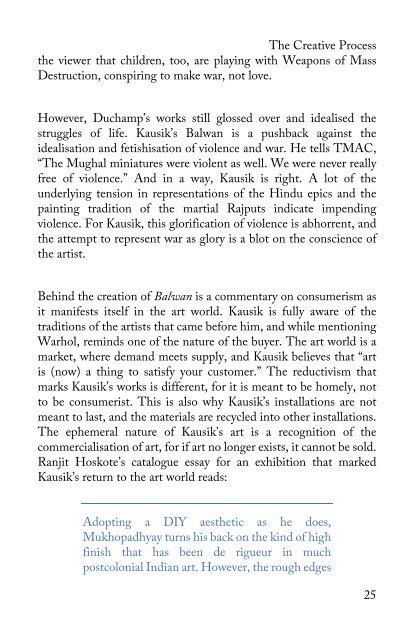The Creative Process: The Arts of War (Spring 2017)
The Creative Process is The Mumbai Art Collective's flagship magazine.
The Creative Process is The Mumbai Art Collective's flagship magazine.
Create successful ePaper yourself
Turn your PDF publications into a flip-book with our unique Google optimized e-Paper software.
<strong>The</strong> <strong>Creative</strong> <strong>Process</strong><br />
the viewer that children, too, are playing with Weapons <strong>of</strong> Mass<br />
Destruction, conspiring to make war, not love.<br />
However, Duchamp’s works still glossed over and idealised the<br />
struggles <strong>of</strong> life. Kausik’s Balwan is a pushback against the<br />
idealisation and fetishisation <strong>of</strong> violence and war. He tells TMAC,<br />
“<strong>The</strong> Mughal miniatures were violent as well. We were never really<br />
free <strong>of</strong> violence.” And in a way, Kausik is right. A lot <strong>of</strong> the<br />
underlying tension in representations <strong>of</strong> the Hindu epics and the<br />
painting tradition <strong>of</strong> the martial Rajputs indicate impending<br />
violence. For Kausik, this glorification <strong>of</strong> violence is abhorrent, and<br />
the attempt to represent war as glory is a blot on the conscience <strong>of</strong><br />
the artist.<br />
Behind the creation <strong>of</strong> Balwan is a commentary on consumerism as<br />
it manifests itself in the art world. Kausik is fully aware <strong>of</strong> the<br />
traditions <strong>of</strong> the artists that came before him, and while mentioning<br />
<strong>War</strong>hol, reminds one <strong>of</strong> the nature <strong>of</strong> the buyer. <strong>The</strong> art world is a<br />
market, where demand meets supply, and Kausik believes that “art<br />
is (now) a thing to satisfy your customer.” <strong>The</strong> reductivism that<br />
marks Kausik’s works is different, for it is meant to be homely, not<br />
to be consumerist. This is also why Kausik’s installations are not<br />
meant to last, and the materials are recycled into other installations.<br />
<strong>The</strong> ephemeral nature <strong>of</strong> Kausik’s art is a recognition <strong>of</strong> the<br />
commercialisation <strong>of</strong> art, for if art no longer exists, it cannot be sold.<br />
Ranjit Hoskote’s catalogue essay for an exhibition that marked<br />
Kausik’s return to the art world reads:<br />
Adopting a DIY aesthetic as he does,<br />
Mukhopadhyay turns his back on the kind <strong>of</strong> high<br />
finish that has been de rigueur in much<br />
postcolonial Indian art. However, the rough edges<br />
25



